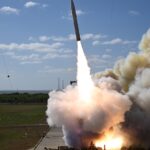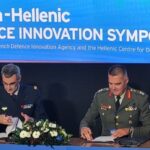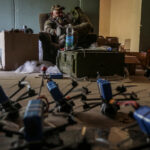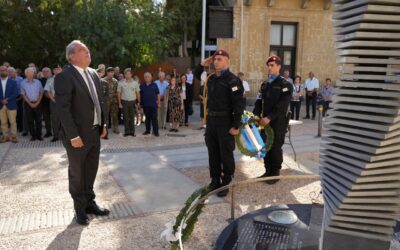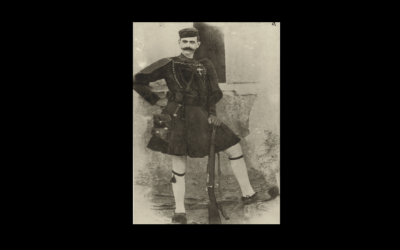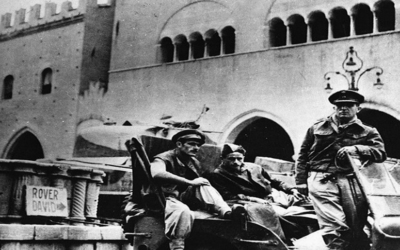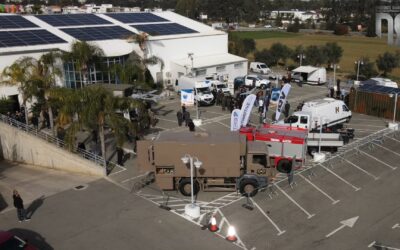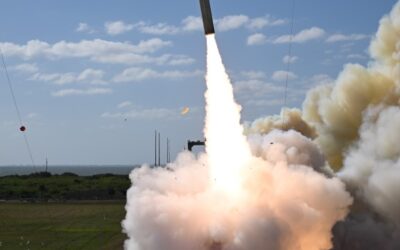The Minister of Defence of the Republic of Cyprus, Mr. Vassilis Palmas, attended the annual commemoration of the fallen of the 3rd…
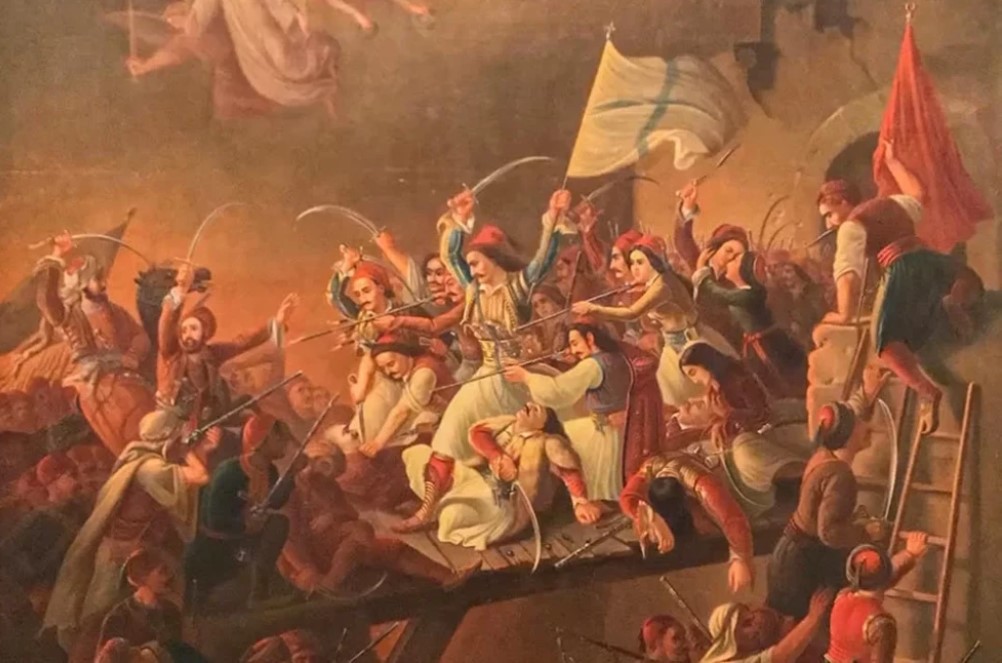
Three years after the failed attempt of Kioutachis and Omer Vryonis to capture Messolonghi, the Sultan had a new plan.
He once again ordered the winner of the Battle of Peta, Kioutachis, to capture the city, this time in collaboration with Ibrahim’s campaign in the Peloponnese. With a powerful army of 20,000 men, Kioutachis set off from Trikala at the end of February 1825, and on April 15, 1825 he arrived in Messolonghi.
The operation to besiege the city includes two phases: a) April 15 to December 12, 1825 and b) December 25, 1825 to April 11, 1826. Without having any substantial help from the rest of the Greeks, due to the civil war, and facing superior enemy forces, the 12,000 souls of Messolonghi showed stout resistance for a year. The organization of the defence was undertaken by a three-member committee led by Ioannis Papadiamantopoulos, Dimitrios Themelis, and Georgios Kanavos.
Following the first phase of the siege, the fortress of the city was improved, following the efforts of Alexandros Mavrokordatos, Byron and the engineer Michael Kokkinis. The trench was now deeper, the small enclosure was strengthened with turrets and multangular surrounding walls, on which 48 cannons and 4 grenade launchers were mounted. The islet of Vasiladi, between the lagoon and the sea, was turned into an advanced fortress.
Six cannons were placed there and 2,000 women and children were gathered so as not to burden the city’s garrison. Within Messolonghi, there were 10,000 people, of which 4,000 were men, excellent warriors from Epirus and Aitoloakarnania and another 1,000 men capable of bearing arms.
During the first phase of the siege (April 15 – December 12, 1825) Messolonghi was besieged only by Kioutachis’ forces. Their attacks were easily or hardly defeated by the defenders of the city. Besides, the blockade by sea was not strong and was repeatedly broken by the fleet of Miaoulis, who reinforced the besieged with munitions and food.
Also read: Pontic Genocide | 104 years since the uprooting and extermination of Pontic Hellenism
On July 24, 1000 Rumelian warriors under the command of Georgios Karaiskakis forced Kioutachis to withdraw his forces to the foothills of Mount Zygos, loosening the siege of Messolonghi. However, the Turkish fleet, also harassed by the Greek, was forced to seek refuge in the British-occupied Cephalonia.
On August 5, Kitsos Tzavellas, leader of a force of Souli warriors, entered the city, reviving the morale of the besieged. However, at the beginning of November, 8,000 Egyptian soldiers of the joint Turkish and Egyptian fleet landed there and a month later Ibrahim arrived in the area and had almost suppressed the Revolution in the Peloponnese. There were 25,000 Turks, Turkalvans, and Egyptians equipped with modern artillery under the command of French officers. The Greeks had to line up 4,000 fighters.
The second phase of the siege of Messolonghi began on December 25, 1825. Similarly to the first phase, there was a disparity of views between the two sides. Egyptian Ibrahim attempted with his own forces to capture Messolonghi on January 16, 1826. He failed, however, and was forced to collude with Kioutachis. The two armies made the siege suffocating with relentless cannon fire over Messolonghi and the capture of the strategically important islets of Vasiladi (February 25) and Kleisovas (March 25). After the fall of the two islets, the besieged were now in a dire situation, after Miaoulis failed to break the naval blockade.
The situation in the city had now reached a breaking point. There was no food and the besieged (women, children, wounded, old men, and fighters) were fed on seaweed, skins, mice, and cats! Under these circumstances, which made the effective defence of the city impossible, a council of chiefs and primates decided on April 6 on their exodus which would take place on Lazarus Saturday to Palm Sunday (April 9 to 10).
At midnight, according to the plan, they were divided into three groups, led by Dimitrios Makris, Notis Botsaris, and Kitsos Tzavelas, in the hope of breaking through the enemy lines, taking advantage of the besiegers’ surprise. Earlier they had killed the Turkish prisoners, while the wounded and the old remained in the city.
Nonetheless, the exodus plan was either betrayed or not implemented properly, so Ibrahim’s forces massacred the freedom fighters with their yatagans. In the meantime, in Messolonghi, the massacres had begun by the Turkish Egyptians, who had invaded from another part of the city.
Also read: Remembrance Day of the Greek Jewish Martyrs and Heroes of the Holocaust
Dramatic scenes took place in many places: when mayor Christos Kapsalis was surrounded by the invaders in his house, where the wounded, elderly, women, and children had gathered, he set fire to the gunpowder warehouse, while the metropolitan Rogon Iosif blew up the Windmill, in the last act of resistance, when surrounded by enemies. On the morning of April 10, Palm Day, the Ottoman flag fluttered over the ruins of Messolonghi.
Available information about the losses of the Greeks during the siege and the exodus is contradictory. It seems more likely that of the 3,000 who took part in the exodus, 1,700 fell heroically fighting. Among the dead, Ioannis Papadiamantopoulos, Michael Kokkinis, Athanasios Razikotsikas, Nikolaos Stornaris, the German publisher of the “Hellenic Chronicles” newspaper Iakovos Mayer and other German Philhellenes.
Around 6,000 women and children were sold in Methoni and the slave markets of Constantinople and Alexandria. The casualties of the invading Turco-Egyptians amounted to 5,000 men. The Revolution, after the fall of Messolonghi, was almost suppressed. Its flame, however, remained unquenched as defeat turned into victory. A new wave of Philhellenism emerged after the end of the Resistance due to the civil strife. This, in turn, indirectly influenced European diplomacy for the national rights of the Greeks.
Many works, paintings, literary works and others immortalized the sacrifice of Messolonghi. Our national poet Dionysios Solomos wrote his unfinished poem “The Free Besieged”, with the following well-known verses from Fragment B:
“Silence reigns on the plain
A bird sings, getting a seed, and the mother is envious of it.
The eyes blackened by hunger, on the eyes the mother swears
The man from Souli stands, crying to his rifle:
‘Why am I holding you?
As you have become a burden and the Hagarines know it’”
Immediately after the capture of Messolonghi, Kioutachis with his army headed towards Eastern Central Greece, seeking to capture Attica. Ibrahim returned to the Peloponnese to eliminate the last pockets of resistance in Mani and Argolis.
Messolonghi was liberated on May 11, 1829. In 1937, it was recognized as a “Holy City” and Palm Sunday was designated as the anniversary of the exodus.
Source: SanSimera.gr
Also read: September 2, 1958 | Battle at the Barn of Liopetri – The four EOKA Heroes
READ MORE
120 years since the death of Pavlos Melas—The Hero of the Macedonian Struggle—Photos
The Armed Forces honor the memory of the ethnic martyr who gave his life for the liberation of Macedonia…
80 years since the Battle of Rimini – The Brigade that wrote golden pages of history
The “Rimini Brigade” wrote new pages of history for Greece, placing it in the camp of the winners. This success was linked to hope and…
BATTLEFIELD ReDEFiNED 2024 | The premier Defence and Security Conference Successfully Concludes in Cyprus – Photos
The International Defence and Security Conference “BATTLEFIELD ReDEFiNED 2024” was successfully concluded on Friday, 13, December 2024…
Dark Eagle | Successful Test of Hypersonic Missile by the US Army
The US Army has successfully conducted a test launch of its new hypersonic missile system, “Dark Eagle,” after two years of delays.
GCAP | Industry Partners Reached a Landmark Agreement to Deliver Next-Gen Combat Aircraft
BAE Systems (UK), Leonardo (Italy), and Japan Aircraft Industrial Enhancement Co Ltd (JAIEC) have reached an agreement to form a new…
Completion of the French-Hellenic Defence Innovation Symposium
On 12 and 13 December, 2024, the Hellenic Centre of Defence Innovation (HCDI) organised the first French-Hellenic Defence Innovation…
Ukraine | Receipt of 1.2 Million Drones in 2024
The Ukrainian Ministry of Defence announced that it had supplied 1.2 million unmanned aerial vehicles to the Ukrainian army in 2024.
Germany | Record Arms Exports to Turkey
German arms exports and defence ties have effectively been on hold since 2016. However, this is now changing due to the complex…









